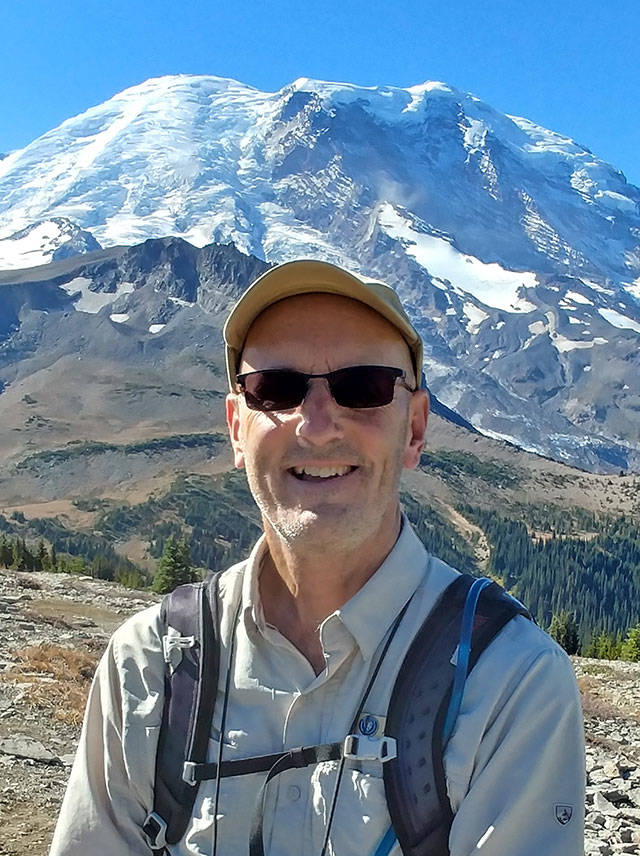In previous columns of All Things Mount Rainier, we saw that the active volcano that dominates our southeastern skyline is rife with geologic hazards. Its history of volcanic mudflows, also known as lahars, places communities in the mountain’s low-lying river valleys at considerable risk.
To the looming threat of lahars and other debris flows, add the dozens of eruptions through the ages that spewed ash and other volcanic debris. With such life-threatening possibilities, you’d expect people to avoid such a dangerous place, right? Well, that’s not exactly the case.
As soon as European Americans began settling the Puget Sound region in the mid-1800s, the mountain began calling out to them. Among the first to heed the call was 20-year old Dr. William Tolmie, fresh out of medical school at Glasgow University and assigned to the Hudson Bay Company’s Fort Nisqually in 1833. Led by five Nisqually and Puyallup Indians, Tolmie’s botanizing trip explored the northwest section of today’s Mount Rainier National Park.
For those wishing to learn the history of explorations and ascents of Mount Rainier, many excellent books abound. Old-time history buffs will enjoy Edmond Meany’s Mount Rainier: A Record of Exploration, which includes the trip reports of Lieutenant August Kautz’s 1857 summit attempt, Hazard Stevens’ successful 1870 ascent, and other early expeditions. Aubrey Haines’ Mountain Fever: Historic Conquests of Rainier adds recent adventures, but Dee Molenaar’s The Challenge of Rainier is the granddaddy of Mount Rainier’s climbing record. Molenaar, a Pacific Northwest icon, passed away this year at 101 years of age after a remarkable life as a climber, guide, cartographer, artist, and author.
Were Tolmie, Kautz, and the other 19th century explorers the first people to clamber about on Mount Rainier’s flanks? Far from it. Over the last 60 years, interviews of tribal elders, archaeological excavations, and other research have shown that Native Americans have traveled to Mount Rainier for thousands of years.
Prior to this surge of information, however, people knew very little of Indian people going into the high country. Many nonnatives, including anthropologists and archaeologists, believed that native people avoided montane environments. (Note: Since the region’s First People use “Indian” to describe themselves, I use it also.)
Lieutenant Kautz illustrated this prevailing notion in writing about his summit attempt that “Information relating to the mountain was exceedingly meager; no white man had been near it, and Indians were superstitious and afraid of it.” Hazard Stevens echoed similar sentiments in his accounts.
This mistaken belief about Native Americans began to change in the summer of 1963 when Allan Smith, an anthropologist at Washington State University, interviewed elders on the Yakama, Muckleshoot, and Nisqually Indian reservations. At Muckleshoot, Smith interviewed Matilda Barr and Louie Starr. At Nisqually, he interviewed Angeline and Willie Frank, parents of the renowned tribal leader and activist Billy Frank Jr.
With some additional research, Smith brought forward a substantial body of new knowledge about the presence of indigenous people at Mount Rainier. He learned that people went to the mountains for several reasons, including for spiritual purposes and traveling through to visit relatives on the other side. But the principal reason, the elders said, was to access resources unavailable near their lowland villages. People prized mountain goats for their thick hides and warm wool, later made into blankets or robes. They hunted marmots and other mountain environment critters, too. They collected bear grass for use as decorative patterns in basket making, and gathered other plants for medicinal uses. One of the most sought after resources was huckleberries. Who doesn’t love huckleberries? People ate them fresh of course, but they also dried them on racks over low-intensity fires or alongside a smoldering log. Transported home and rehydrated over the winter months, the berries were an important source of vitamin C.
Following the interviews, Smith turned his notes over to his colleague, archaeologist Richard Daugherty. Daugherty and some graduate students soon set out on foot to explore Mount Rainier in hopes of finding evidence of Indian presence. Acting on a tip from a park ranger, they located a rock shelter on the northeastern side of the mountain. Researchers excavating the site the next year found over 100 stone tools and bits of chip stone tooling debris, along with some animal bones and teeth. Known as the Fryingpan Creek rock shelter, it was a camp used over 1,000 years ago, probably by Klickitat and Yakama hunters. The first archeological site at Mount Rainier and the highest elevation dig in Washington state at the time, the rock shelter was big news to experts. Surely, it would dispel the false assumption that Native Americans avoided mountainous areas.
But unfortunately, Smith’s report collected dust on the park library’s shelves for decades until finally published as Takhoma: Ethnography of Mount Rainier National Park. The stone tools and other recovered items landed in a university storeroom, forgotten. It would take years of work from archaeologists, park staff, and tribal members until they could share with park visitors the full story of native people venturing onto Mount Rainier’s slopes.
In our next column, we’ll “visit” some ancient Native American camps on the mountain and learn about the development of the park’s noteworthy archaeological record. In the meantime, keep your boots dry and your spirits high.
Jeff Antonelis-Lapp is an educator, naturalist, and writer living in Enumclaw since 1982. Tahoma and Its People, his natural history of Mount Rainier National Park, was published this spring by Washington State University Press. Copies are available at https://jeffantonelis-lapp.com/. Jeff would love to hear from you about Mount Rainier. Send your questions and favorite stories to rstill@courierherald.com, and subscribe to his blog, too.


